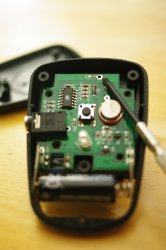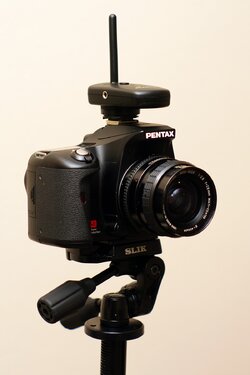BobSaget
TPF Noob!
- Joined
- Nov 15, 2012
- Messages
- 151
- Reaction score
- 29
- Location
- New Olreans
- Can others edit my Photos
- Photos OK to edit
It's been a while since I posted on this forum, but thought I'd share this recent modification i made to a Promaster flash trigger. I noticed i wasn't getting much distance out of the thing and decided to take a look at the circuit board and see what kind of antennae was inside.
1
As you can see, there was no antenna to be found but there was a port on the board for one (I have my screwdriver pointed at it.) I tested this by getting out of range and then connecting a wire to the port to see if i could get it to fire and was successful. I ran over to a thrift store and found a 2 dollar cordless phone with a nice stubby rubber antenna.
2
Next, had to do a little drilling and soldering and here's my end result.
3
Added bonus, while i was at the thrift store i found a Slik Tripod head for 7 bucks. (in pic 3)
1

As you can see, there was no antenna to be found but there was a port on the board for one (I have my screwdriver pointed at it.) I tested this by getting out of range and then connecting a wire to the port to see if i could get it to fire and was successful. I ran over to a thrift store and found a 2 dollar cordless phone with a nice stubby rubber antenna.
2

Next, had to do a little drilling and soldering and here's my end result.
3

Added bonus, while i was at the thrift store i found a Slik Tripod head for 7 bucks. (in pic 3)


 . Basically, when i noticed i was getting a result when going back and forth, ae on, ae off, I figured it would be worth it. Sometimes my interest in taking things apart and screwing with them outweighs the practicality but i think i may get a good result with this one.
. Basically, when i noticed i was getting a result when going back and forth, ae on, ae off, I figured it would be worth it. Sometimes my interest in taking things apart and screwing with them outweighs the practicality but i think i may get a good result with this one.

![[No title]](/data/xfmg/thumbnail/35/35269-511d1e0ac8ed5256fd706829d2ecb719.jpg?1619736972)





![[No title]](/data/xfmg/thumbnail/32/32929-22e23acc63d6ecb25e5ee941be87121f.jpg?1619735758)
